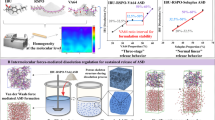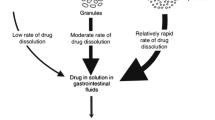Abstract
The aim of this paper was to evaluate the performance of different swellable polymers in the form of layered matrix tablets to provide controlled therapeutic effect of metoprolol tartrate for twice daily administration. Seven different swellable polymers (carrageenan, hydroxypropylmethyl cellulose, pectin, guar gum, xanthan gum, chitosan, and ethyl cellulose) were evaluated alone or in combination as release-retardant layer. Tablets were tested for weight variation, hardness, diameter/thickness ratio, friability, and drug content uniformity and subjected to in vitro drug-release studies. In addition, the target-release profile of metoprolol tartrate was plotted using its clinical pharmacokinetic data, and the release profiles of the tablets were evaluated in relation to the plotted target release profile. Carrageenan was determined as the best polymer in two-layered matrix tablet formulations due to its better accordance to the target release profile and was selected for preparing three-layered matrix tablets. Carrageenan formulations exhibited super case II release mechanism. Accelerated stability testing was performed on two- and three-layered matrix tablet formulations of carrageenan. The tablets were stored at 25°C/60% relative humidity and 40°C/75% relative humidity for 6 months and examined for physical appearance, drug content, and release characteristics. At the end of the storage time, formulations showed no change either in physical appearance, drug content, or drug-release profile. These results demonstrated the suitability of three-layered tablet formulation of carrageenan to provide controlled release and improved linearity for metoprolol tartrate in comparison to two-layered tablet formulation.











Similar content being viewed by others
References
Ye Z, Rombout P, Remon JP, Vervaet C, Van den Mouter G. Correlation between the permeability Metoprolol tartrate through plasticized isolated Ethylcellulose/Hydroxypropyl Methylcellulose films and drug release from reservoir pellets. Eur J Pharm Biopharm. 2007;67:485–90.
Krishnaiah YSR, Karthikayen RS, Satyanarayana V. A three-layer Guar Gum matrix tablet for oral controlled delivery of highly soluble Metoprolol tartrate. Int J Pharm. 2002;241(2):353–66.
Hong S, Oh SY. Dissolution kinetics and physical characterization of three-layered tablet with poly(ethylene oxide) core matrix capped by Carbopol. Int J Pharm. 2008;356:121–9.
Gennaro AR. Remington’s Pharmaceutical Sciences. 18th ed. Eaton: Mack; 1990.
Eddington ND, Marroum P, Uppoor R, Hussain A. Development and internal validation of an in vitro–in vivo correlation for a hydrophilic Metoprolol tartrate extended-release tablet formulation. Pharm Res. 1998;15:466–73.
Cosijns A, Vervaet C, Luyten J, Mullens S, Siepmann F, Van Hoorebeke L et al. Porous hydroxyapatite tablets as carriers for low-dosed drugs. Eur J Pharm Biopharm. 2007;67:498–506.
Verhoeven E, De Beer TRM, Van den Mooter G, Remon JP, Vervaet C. Influence of formulation and process parameters on the release characteristics of Ethylcellulose sustained-release mini-matrices produced by hot-melt extrusion. Eur J Pharm Biopharm. 2008;69:312–9.
Nakamura K, Nara E, Akiyama Y. Development of an oral sustained release drug delivery system utilizing pH-dependent swelling of Carboxyvinyl polymer. J Control Release. 2006;111:309–15.
Aqıl M, Sultana Y, Alı A. Matrix type transdermal drug delivery systems of Metoprolol tartrate: in vitro characterization. Acta Pharm. 2003;53:119–25.
Narendra C, Srinath MS, Prakash Rao B. Development of three layered buccal compact containing Metoprolol tartrate by statistical optimization technique. Int J Pharm. 2005;304:102–14.
Ghosh LK, Sairam P, Gupta BK. Development and evaluation of an oral controlled release multiple emulsion drug delivery system of a specific beta blocker Metoprolol tartrate. Boll Chim Farm. 1996;135:468–71.
Ganga S, Ramarao R, Singh J. Effect of Azone on the iontophoretic transdermal delivery of Metoprolol tartrate through human epidermis in vitro. J Control Release. 1996;42:57–64.
Pillay V, Fassihi R. A novel approach for constant rate delivery of highly soluble bioactives from a simple monolithic system. J Control Release. 2000;67:67–78.
Özyazıcı M, Gökçe EH, Ertan G. Release and diffusional modeling of metronidazole lipid matrices. Eur J Pharm Biopharm. 2006;63:331–9.
Özgüney I, Ertan G, Güneri T. Dissolution characteristics of megaloporous tablets prepared with two kinds of matrix granules. Il Farmaco. 2004;59(7):549–55.
The United States Pharmacopeia. The National Formulary: USP XXIV, NF XIX. Rockville: The United States Pharmacopeia; 2000.
Martinez-Pacheco R, Vila-Vato JL, Sauto C, Pamos T. Controlled release of Cephalexin from double-layer tablets containing small proportions of Acrylic Resins. Int J Pharm. 1986;32:99–102.
Hardman JG, Limbird LE, Gilman AG. Goodman & Gilman’s The Pharmacological Basis of Therapeutics. 10th ed. New York: McGraw-Hill; 2001.
Jack D. Handbook of Clinical Pharmacokinetic Data. London: Macmillan; 1992.
Ritger PL, Peppas NA. A simple equation for description of solute release II. Fickian and anomalous release from swellable devices. J Control Release. 1987;5:37–42.
Al-Gohary OMN, Al-Kassas RS. Stability studies of Aspirin–magaldrate double layer tablets. Pharm Acta Helv. 2000;74:351–60.
Mathews BR. Regulatory aspects of stability testing in Europe. Drug Dev Ind Pharm. 1999;25:831–56.
Avdeef A, Berger CM. pH-metric solubility. Dissolution titration template method for solubility determination. Eur J Pharm Sci. 2001;14:281–91.
Meshali MM, Gabr KE. Effect of interpolymer complex formation of chitosan with pectin or acacia on the release behaviour of chlorpromazine HCl. Int J Pharm. 1993;89(3):177–81.
Bonferoni MC, Rossi S, Ferrari F, Bertoni M, Bolhuis GK, Caramella C. On the employment of λ carrageenan in a matrix system. III. Optimization of a λ carrageenan-HPMC hydrophilic matrix. J Control Release. 1998;51:231–9.
Hejazi R, Amiji M. Chitosan- based gastrointestinal delivery systems. J Control Release. 2003;89:151–65.
Tapia C, Escobar Z, Costa E, Sapag-Hagar J, Valenzuela F, Basualto C et al. Comparative studies on polyelectrolyte complexes and mixtures of Chitosan-alginate and Chitosan-carrageenan as prolonged Diltiazem Clorhydrate release systems. Eur J Pharm Biopharm. 2004;57:65–75.
Remunan-Lopez C, Portero A, Vila-Jato JL, Alonso MJ. Design and evaluation of Chitosan/Ethylcellulose mucoadhesive bilayered devices for buccal drug delivery. J Control Release. 1998;55:143–52.
Miyazaki S, Kawasaki N, Nakamura T, Iwatsu M, Hayashi T, Hou WM et al. Oral mucosal bioadhesive tablets of pectin and HPMC: in vitro and in vivo evaluation. Int J Pharm. 2000;204:127–32.
Grabovac V, Föger F, Bernkop-Schnürch A. Design and in vivo evaluation of a patch delivery system for insulin based on thiolated polymers. Int J Pharm. 2008;348:169–74.
Colombo P, Bettini R, Santi P, Peppas NA. Swellable matrices for controlled drug delivery: gel-layer behaviour, mechanisms and optimal performance. Pharm Sci Technolo Today. 2000;3(6):198–204.
Baloğlu E, Özyazıcı M, Hızarcıoğlu SY, Şenyiğit T, Özyurt D, Pekçetin Ç. Bioadhesive controlled release systems of ornidazole for vaginal delivery. Pharm Dev Technol. 2006;11:477–84.
Guo J, Skinner GW, Harcum WW, Barnum PE. Pharmaceutical applications of naturally occurring water-soluble polymers. Pharm Sci Technolo Today. 1998;1:254–61.
Sriamornsak P, Thirawong N, Weerapol Y, Nunthanid J, Sungthongjeen S. Swelling and erosion of pectin matrix tablets and their impact on drug release behavior. Eur J Pharm Biopharm. 2007;67:211–9.
Sujja-areevath J, Munday DL, Cox J, Khan KA. Relationship between swelling, erosion and drug release in hydrophilic natural gum mini-matrix formulations. Eur J Pharm Sci. 1998;6:207–17.
Bonferoni MC, Rossi S, Tamajo M, Pedraz JL. Dominguez Gil A, Caramella C. On the employment of λ carrageenan in a matrix system. I. Sensitivity to dissolution medium and comparison with Na carboxymethylcellulose and xanthan gum. J Control Release. 1993;26:119–27.
Feely LC, Davis SS. The influence of polymeric excipients on drug release from hydroxypropylmethylcellulose matrices. Int J Pharm. 1988;44:131–9.
Rango Rao KV, Padmalatha Devi K, Buri P. Influence of molecular size and water solubility of the solute on its release from swelling and erosion controlled polymeric matrices. J Control Release. 1990;12:133–41.
Fassihi RA, Ritschel WA. Multiple-layer, direct-compression, controlled-release system: in vitro and in vivo evaluation. J Pharm Sci. 1993;82:750–4.
Streubel A, Siepmann J, Peppas NA, Bodmeier R. Bimodal drug release achieved with multi-layer matrix tablets: transport mechanisms and device design. J Control Release. 2000;69:455–68.
Lee PI, Peppas NA. Prediction of polymer dissolution in swellable controlled-release systems. J Control Release. 1987;6:207–15.
Kim H, Fassihi R. Application of a binary polymer system in drug release rate modulation. I. Characterisation of release mechanism. J Pharm Sci. 1996;86:316–22.
Kim H, Fassihi R. A new ternary polymeric matrix system for controlled drug delivery of highly soluble drugs. I. Diltiazem Hydrochloride. Pharm Res. 1997;14:1415–21.
Sangalli ME, Maroni A, Zema L, Cerea M, Conte U, Gazzaniga A. A study on the release mechanism of drugs from hydrophilic partially coated perforated matrices. Il Farmaco. 2003;58:971–6.
Picker KM. The use of carrageenan in mixture with microcrystalline cellulose and its functionality for making tablets. Eur J Pharm Biopharm. 1999;48:27–36.
Bamba M, Puisieux JP, Marty JP, Carstensen JT. Physical model for release of drug from gel forming sustained release preparations. Int J Pharm. 1979;3:87–92.
Bamba M, Puisieux JP, Marty JP, Carstensen JT. Release mechanisms in gel forming sustained release preparations. Int J Pharm. 1979;2:307–15.
Acknowledgments
The authors wish to thank Research Foundation of Ege University for financial support given to this study (15/ECZ/2002).
Author information
Authors and Affiliations
Corresponding author
Rights and permissions
About this article
Cite this article
Baloğlu, E., Şenyiğit, T. A Design and Evaluation of Layered Matrix Tablet Formulations of Metoprolol Tartrate. AAPS PharmSciTech 11, 563–573 (2010). https://doi.org/10.1208/s12249-010-9409-9
Received:
Accepted:
Published:
Issue Date:
DOI: https://doi.org/10.1208/s12249-010-9409-9




